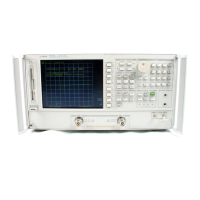5. Press
L24)
Lxl] to count the frequency of the
2nd
Lo
signal.
.
. . . . .
6-
Press
Ihnenu_)
~$ji!t~:~t~~~~
Lsoo]
Ck/m.
Verify that the counter reading matches
the corresponding
2nd
Lo
value for the CW frequency. (Refer to
‘lhble
7-2.)
7. Verify the remaining CW frequencies, comparing the counter reading with
the value in
Table
7-2:
n
Press
(FJ
(i&i).
n
Press
(%GJ
Irln_u.
8. Press
L25_)
Lxl] to count the frequency of the PLREF
signai.
9.
Press
@J
~~~~~:
L500)
m.
Verify
that
the
counter
reading
matches
the corresponding PLREF value for the CW frequency. (Refer to
‘Pable
7-2.)
10. Verify the remaining CW frequencies, comparing the counter reading with
the value in
‘lhble
7-2:
n
Press(TJ(l&iJ
n
Press(sol(KiJiJ.
11. Check the results.
q
If
aII
the counter readings match the frequencies
listed
in
Table
7-2, skip
ahead to “A13/A14 Fractional-N Check”.
q
If the counter readings are incorrect at the 500
kHz
and 2 MHz settings
only, go to
‘TN
LO at
Al2
Check”.
q
If
aII
the counter readings are incorrect at
aII
three CW frequencies, the
counter may be faulty. Perform the
“OsciIIoscope
Method” check of the
signals described below. (If the
signais
are good, either the A10 or
Al4
assemblies could be faulty.)
7-14
Source Troubleshooting

